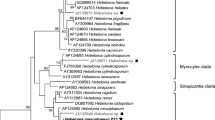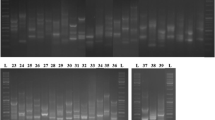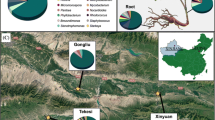Abstract
Fifteen endophytic isolates were recovered from the phytoremediator plant Phragmites. Phylogenetic analysis revealed they were primarily from the class Sordariomycetes and Dothiodiomycetes. Most of the endophytes in Sordariomycetes were from the orders Diaporthales (six isolates, e.g., Diaporthe, Phomopsis), Hypocreales (two isolates, e.g., Gliomastix, Trichoderma), and Xylariales (one isolate, e.g., Arthrinium), while members from Dothideomycetes were from the order Pleosporales (six isolates, e.g., Bipolaris, Curvularia, Microsphaeropsis, Saccharicola). The endophytes demonstrated varying responses to the metals (Al3+, Cu2+, Zn2+, Pb2+, and Cd2+) and concentrations (10, 25, 50, 100, and 200 mg L−1) tested, with isolates of Dothideomycetes predominantly more tolerable to metals (80–97% tolerance) than Sordariomycetes (73–90% tolerance). Pb2+ was the least harmful towards the endophytes, while Al3+ appeared to be highly toxic with mean tolerable range (TR) of > 200 and 25–50 mg L−1, respectively. Endophytes thriving in toxic metals may further be applied for biocontrol, bioremediation, or growth-promoting purposes in metal-contaminated areas.



Similar content being viewed by others
References
Agamuthu, P., & Said, N. A. A. (2009). Physico-chemical treatment of Bukit Tagar sanitary landfill leachate using P-Floc775 and ferric chloride. Malaysian Journal of Science, 28, 187–195.
Almeida, T. T., Orlandelli, R. C., Azevedo, J. L., & Pamphile, J. A. (2015). Molecular characterization of the endophytic fungal community associated with Eichhornia azurea (Kunth) and Eichhornia crassipes (Mart.) (Pontederiaceae) native to the upper Paraná River floodplain, Brazil. Genetics and Molecular Research, 14, 4920–4931.
Anand, P., Isar, J., Saran, S., & Saxena, R. K. (2006). Bioaccumulation of copper by Trichoderma viride. Bioresource Technology, 97, 1018–1025.
Angelini, P., Rubini, A., Gigante, D., Reale, L., Pagiotti, R., & Venanzoni, R. (2012). The endophytic fungal communities associated with the leaves and roots of the common reed (Phragmites australis) in Lake Trasimeno (Perugia, Italy) in declining and healthy stands. Fungal Ecology, 5, 683–693.
Bonanno, G., & Giudice, R. L. (2010). Heavy metal bioaccumulation by the organs of Phragmites australis (common reed) and their potential use as contamination indicators. Ecological Indicators, 10, 639–645.
Botella, L., & Diez, J. J. (2011). Phylogenic diversity of fungal endophytes in Spanish stands of Pinus halepensis. Fungal Diversity, 47, 9–18.
Chow, Y. Y., & Ting, A. S. Y. (2015). Endophytic L-asparaginase-producing fungi from plants associated with anticancer properties. Journal of Advanced Research, 6, 869–876.
Clarke, B. B., White, J. F. J., Hurley, R. H., Torres, M. S., Sun, S., & Huff, D. R. (2006). Endophyte-mediated suppression of dollar spot disease in fine fescues. Plant Disease, 90, 994–998.
Clay, K., Shearin, Z. R. C., Bourke, K. A., Bickford, W. A., & Kowalski, K. P. (2016). Diversity of fungal endophytes in non-native Phragmites australis in the Great Lakes. Biological Invasions, 18, 2703–2716.
Cotton, F. A., & Wilkinson, G. (1988). Advanced inorganic chemistry. New York: John Wiley and Sons.
Crozier, J., Thomas, S. E., Aime, M. C., Evans, H. C., & Holmes, K. A. (2006). Molecular characterization of fungal endophytic morphospecies isolated from stems and pods of Theobroma cacao. Plant Pathology, 55, 783–791.
Davis, A. T., Volesky, B., & Mucci, A. (2003). A review of the biochemistry of heavy metal biosorption by brown algae. Water Research, 37, 4311–4330.
Drasch, G. A. (1983). An increase of cadmium body burden for this century—an investigation on human tissues. Science of the Total Environment, 26, 111–119.
Dunbabin, J. S., & Bowmer, K. H. (1992). Potential use of constructed wetlands for treatment of industrial wastewaters containing metals. Science of the Total Environment, 111, 151–168.
Errasquín, E. L., & Vázquez, C. (2003). Tolerance and uptake of heavy metals by Trichoderma atroviride isolated from sludge. Chemosphere, 50, 137–143.
Farr, D. F., Castlebury, L. A., & Rossman, A. Y. (2002). Morphological and molecular characterization of Phomopsis vaccinii and additional isolates of Phomopsis from blueberry and cranberry in the eastern United States. Mycologia, 94, 494–504.
Felsenstein, J. (1985). Confidence limits on phylogenies: an approach using the bootstrap. Evolution, 39, 783–791.
Freitas, M. O., Abilhoa, V., & da Costa, S. G. H. (2011). Feeding ecology of Lutjanus analis (Teleostei: Lutjanidae) from Abrolhos Bank, eastern Brazil. Neotropical Ichthyology, 9, 411–418.
Gazis, R., Rehner, S., & Chaverri, P. (2011). Species delimitation in fungal endophyte diversity studies and its implications in ecological and biogeographic inferences. Molecular Ecology, 20, 3001–3013.
Gorbushina, A. A., Kotlova, E. R., & Sherstneva, O. A. (2008). Cellular responses of microcolonial rock fungi to long-term dessication and subsequent rehydration. Studies in Mycology, 61, 91–97.
Guillén, Y., & Machuca, A. (2008). The effect of copper on the growth of wood-rotting fungi and a blue-stain fungus. World Journal of Microbiology and Biotechnology, 24, 31–37.
Khan, A. R., Ullah, I., Waqas, M., Park, G. S., Khan, A. L., Hong, S. J., Ullah, R., Jung, B. K., Park, C. E., Ur-Rehman, S., Lee, I. J., & Shin, J. H. (2017). Host plant growth promotion and cadmium detoxification in Solanum nigrum, mediated by endophytic fungi. Ecotoxicology and Environmental Safety, 136, 180–188.
Kimmons, C. A., Gwinn, K. D., & Bernard, E. C. (1990). Nematode reproduction on endophyte-infected and endophyte-free tall fescue. Plant Disease, 74, 757–761.
Kumar, S., Stecher, G., & Tamura, K. (2016). MEGA7: molecular evolutionary genetics analysis version 7.0 for bigger datasets. Molecular Biology and Evolution, 33, 1870–1874.
Lόpez-Archilla, A. I., González, A. E., Terrόn, M. C., & Amils, R. (2004). Ecological study of the fungal populations of the acidic Tinto River in southwestern Spain. Canadian Journal of Microbiology, 50, 923–934.
Martin, H. (2008). Studies upon the copper fungicides. Annals of Applied Biology, 20, 342–363.
Matthew, P., Austin, R. D., Varghese, S. S., & Manojkumar, A. D. (2015). Effect of copper-based fungicide (bordeaux mixture) spray on the total copper content of areca nut: implications in increasing prevalence of oral submucous fibrosis. Journal of International Society of Preventive and Community Dentistry, 5, 283–289.
Meyerson, L. A., & Cronin, J. T. (2013). Evidence for multiple introductions of Phragmites australis to North America: detection of a new non-native haplotype. Biological Invasions, 14, 2605–2608.
Paraszkiewicz, K., Frycie, A., Slaba, M., & Dlugoński, J. (2007). Enhancement of emulsifier production by Curvularia lunata in cadmium, zinc and lead presence. Biometals, 20, 797–805.
Rao, H. C. Y., Baker, S., Rakshith, D., & Satish, S. (2015). Molecular profiling and antimicrobial potential of endophytic Gliomastix polychroma CLB32 inhabiting Combretum latifolium Blume. Mycology, 6, 176–181.
Redman, R. S., Sheehan, K. B., Stout, R. G., Rodriguez, R. J., & Henson, J. M. (2002). Thermotolerance generated by plant/fungal symbiosis. Science. https://doi.org/10.1126/science.1078055.
Rhee, Y. J., Hillier, S., & Gadd, G. M. (2012). Lead transformation to pyromorphite by fungi. Current Biology, 2, 237–241.
Rodriguez, R. J., Henson, J., Van, V. E., Hoy, M., Wright, L., Beckwith, F., et al. (2008). Stress tolerance in plants via habitat-adapted symbiosis. ISME Journal, 2, 404–416.
Ruibal, C., Gueidan, C., Selbmann, L., Gorbushina, A. A., Crous, P. W., Groenewald, J. Z., Muggia, L., Gurbe, M., Isola, D., Schoch, C. L., Staley, J. T., Lutzoni, F., & de Hoog, G. S. (2009). Phylogeny of rock-inhabiting fungi related to Dothidiomycetes. Studies in Mycology, 64, 123–133.
Saitou, N., & Nei, M. (1987). The neighbor-joining method: a new method for reconstructing phylogenetic trees. Molecular Biology and Evolution, 4, 406–425.
Sauvêtre, A., & Schröder, P. (2015). Uptake of carbamazepine by rhizomes and endophytic bacteria of Phragmites australis. Frontiers in Plant Science. https://doi.org/10.3389/fpls.2015.00083.
Schoch, C. L., Crous, P. W., Groenewald, J. Z., Boehm, E. W. A., Burgess, T. I., de Gruyter, J., et al. (2009). A class-wide phylogenetic assessment of Dothidiomycetes. Studies in Mycology, 64, 1–15.
Schroeckh, V., Scherlach, K., Nützmann, H. W., Shelest, E., Schmidt-Heck, W., Schuemann, J., Martin, K., Hertweck, C., & Brakhage, A. A. (2009). Intimate bacterial-fungal interaction triggers biosynthesis of archetypal polyketides in Aspergillus nidulans. Proceedings of the National Academy of Sciences of the United States of America, 106, 14558–14563.
Sim, C. S. F., Tan, W. S., & Ting, A. S. Y. (2016). Endophytes from Phragmites for metal removal: evaluating their metal tolerance, adaptive behaviour and biosorption efficacy. Désalination and Water Treatment, 57, 6959–6966.
Sirikantaramas, S., Yamazaki, M., & Saito, K. (2009). A survival strategy: the coevolution of the camptothecin biosynthetic pathway and self-resistance mechanism. Phytochemistry, 70, 1894–1898.
Soares, M. A., Li, H. Y., Kowalski, K. P., Bergen, M., Torres, M. S., & White, J. F. (2016). Evaluation of the functional roles of fungal endophytes of Phragmites australis from high saline and low saline habitats. Biological Invasions, 18, 2689–2702.
Tamura, K., Nei, M., & Kumar, S. (2004). Prospects for inferring very large phylogenies by using the neighbour-joining method. Proceedings of the National Academy of Sciences of the United States of America, 101, 11030–11035.
Ting, A. S. Y., & Jioe, E. (2016). In vitro assessment of antifungal activities of antagonistic fungi towards pathogenic Ganoderma boninense under metal stress. Biological Control, 96, 57–63.
Vepachedu, S. K. V. R. R., Akthar, N., & Mohan, P. M. (1997). Isolation of a cadmium tolerant Curvularia sp. from polluted effluents. Current Science, 73, 453–455.
Weaver, L., Michels, H. T., & Keevil, C. W. (2010). Potential for preventing spread of fungi in air-conditioning systems constructed using copper instead of aluminium. Letters in Applied Microbiology, 50, 18–23.
Wirsel, S. G. R., Leibinger, W., Ernst, M., & Mendgen, K. (2001). Genetic diversity of fungi closely associated with common reed. New Phytologist, 149, 589–598.
Young, C. A., Felitti, S., & Shields, K. (2006). A complex gene cluster for indole-diterpene biosynthesis in the grass endophyte Neotyphodium lolii. Fungal Genetics and Biology, 43, 679–693.
Yuan, Z. L., Rao, L. B., Chen, Y. C., Zhang, C. L., & Wu, Y. G. (2011). From pattern to process: species and functional diversity in fungal endophytes of Abies beshanzuensis. Fungal Biology, 115, 197–213.
Zotti, M., Piazza, S. D., Roccotiello, E., Lucchetti, G., Mariotti, M. G., & Marescotti, P. (2014). Microfungi in highly copper-contaminated soils from an abandoned Fe-cu sulphide mine: growth responses, tolerance and bioaccumulation. Chemosphere, 117, 471–476.
Acknowledgements
The authors are grateful to Aw Yoong Kit for his guidance in constructing the phylogenetic tree.
Funding
This work is conducted using facilities by Monash University Malaysia. The first author is also a recipient of the PhD scholarship by Monash University Malaysia.
Author information
Authors and Affiliations
Corresponding author
Ethics declarations
Conflict of Interest
The authors declare that they have no conflict of interest.
Rights and permissions
About this article
Cite this article
Sim, C.S.F., Cheow, Y.L., Ng, S.L. et al. Discovering Metal-Tolerant Endophytic Fungi from the Phytoremediator Plant Phragmites. Water Air Soil Pollut 229, 68 (2018). https://doi.org/10.1007/s11270-018-3733-1
Received:
Accepted:
Published:
DOI: https://doi.org/10.1007/s11270-018-3733-1




